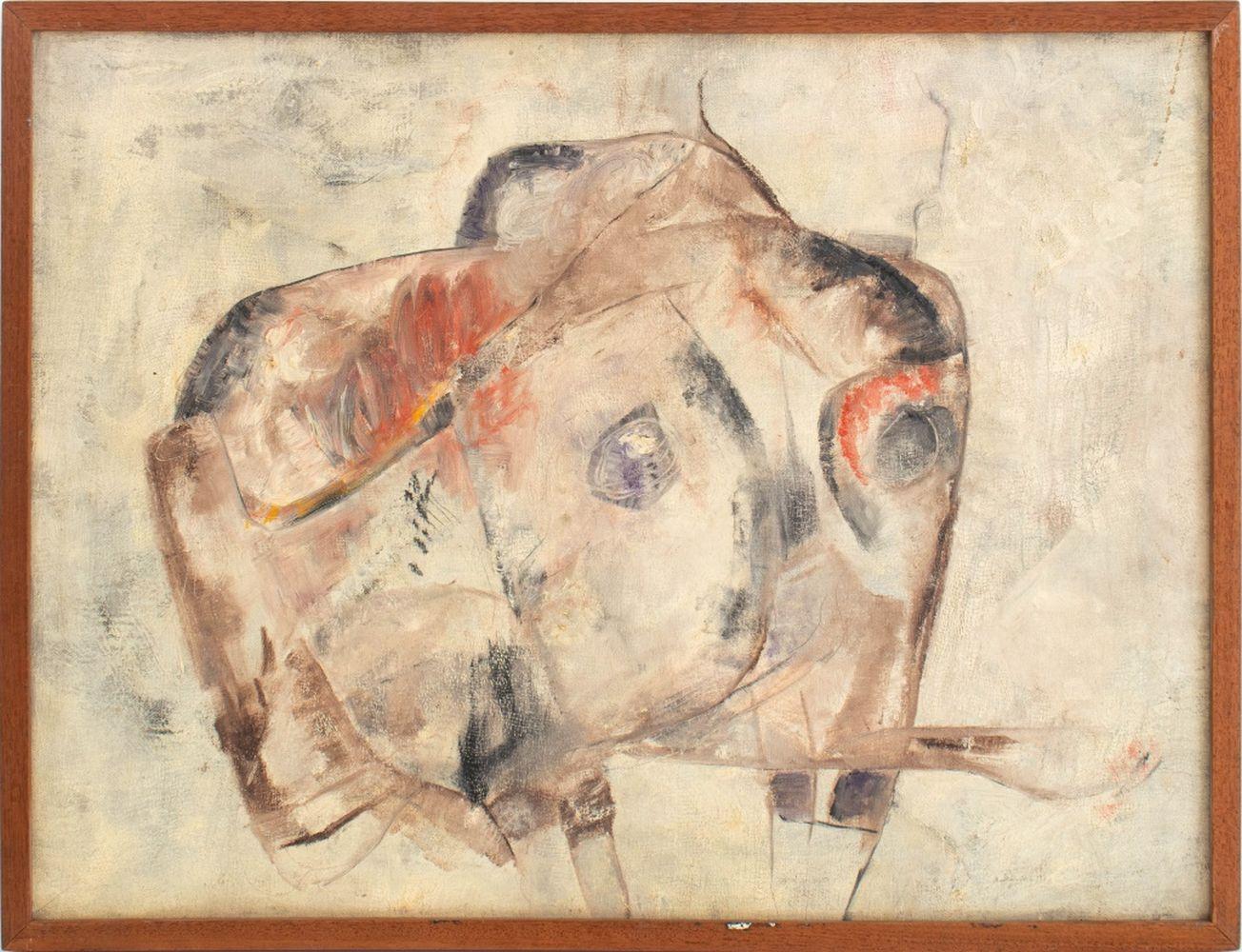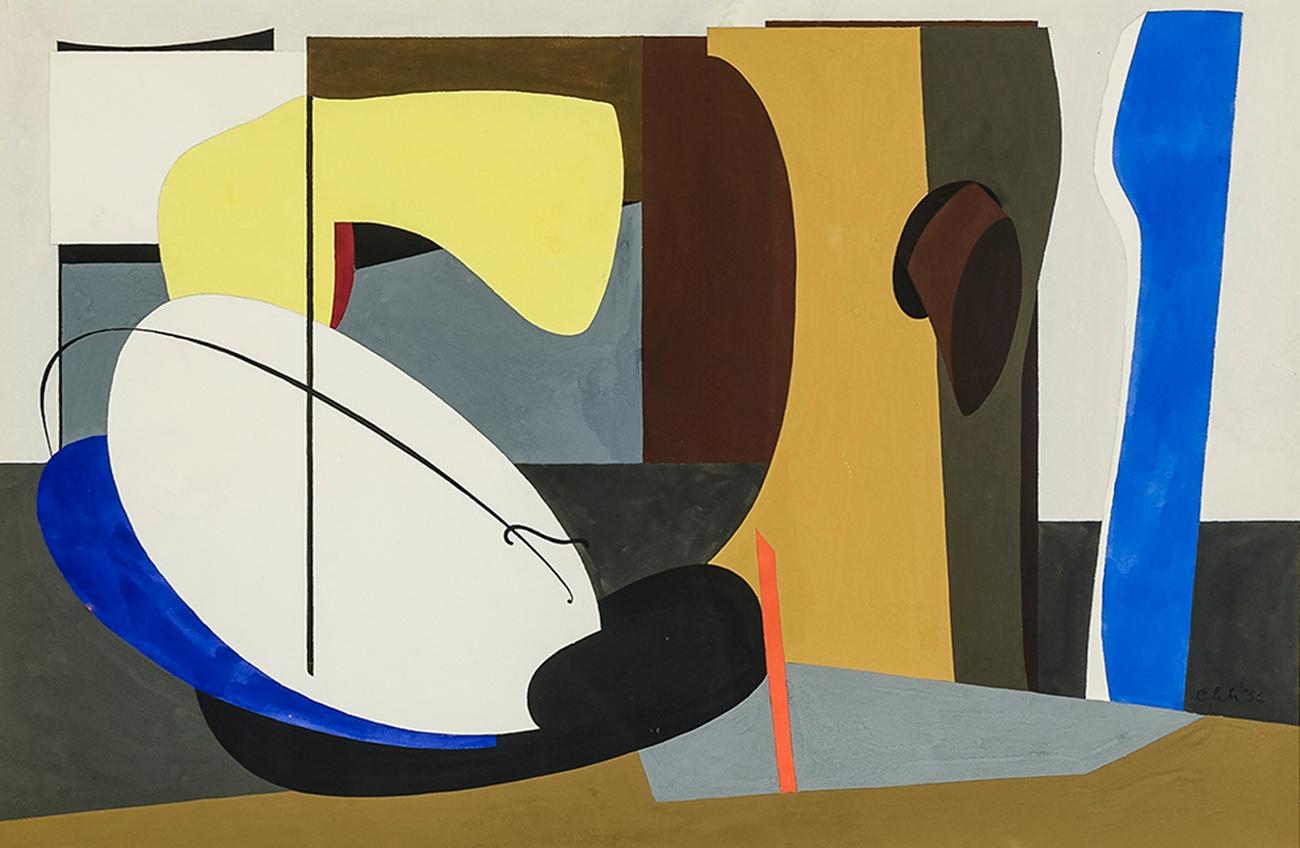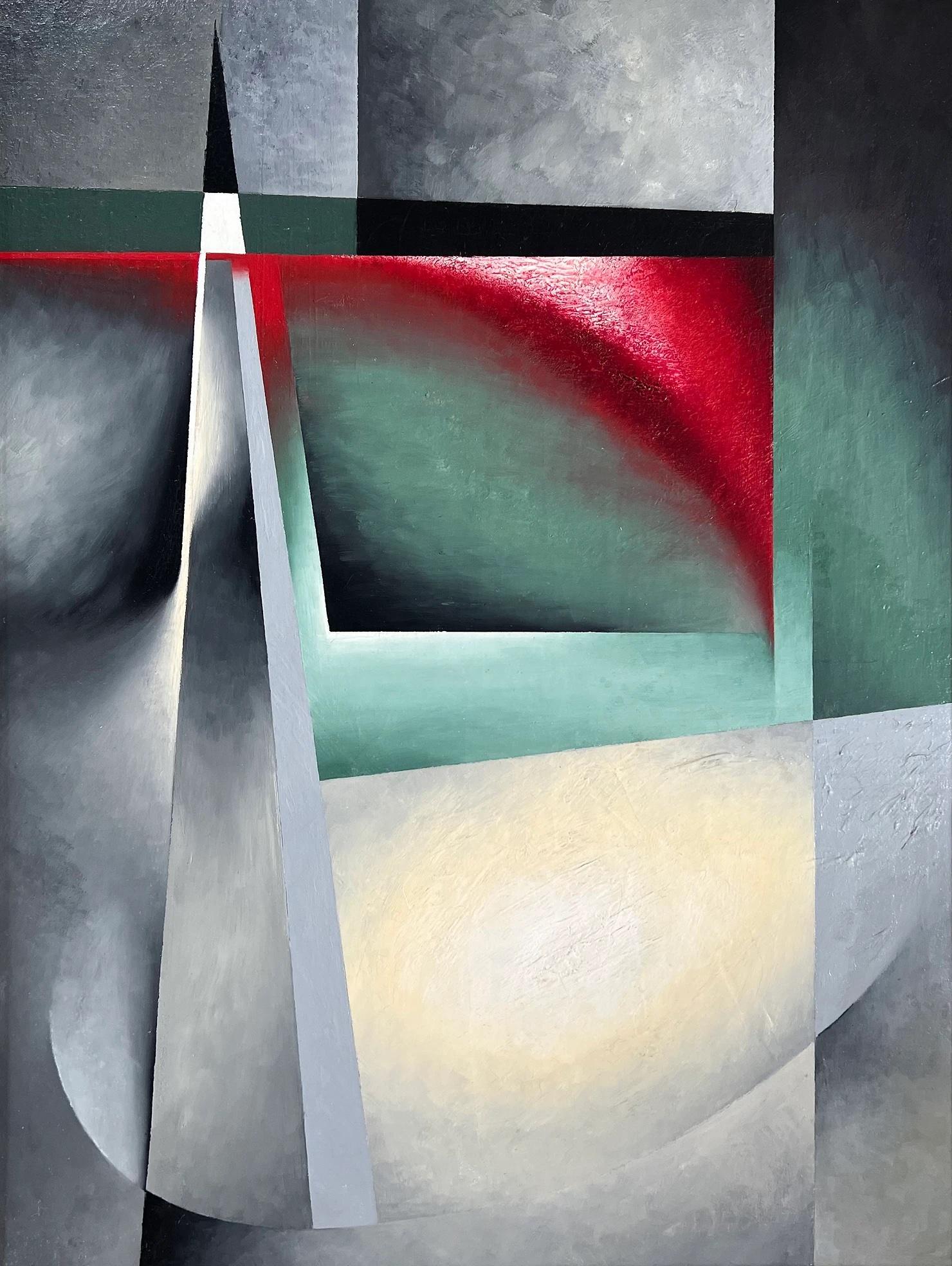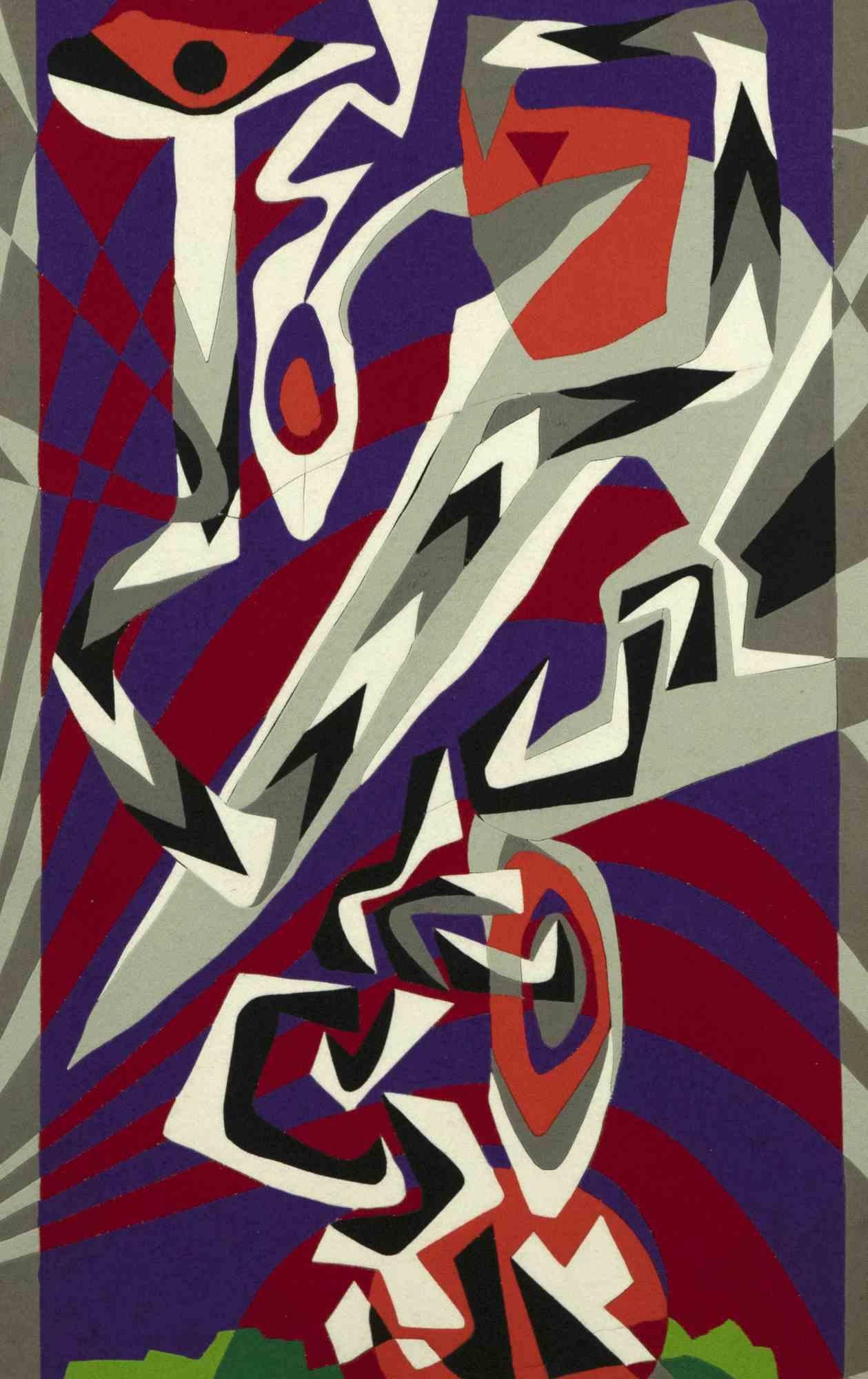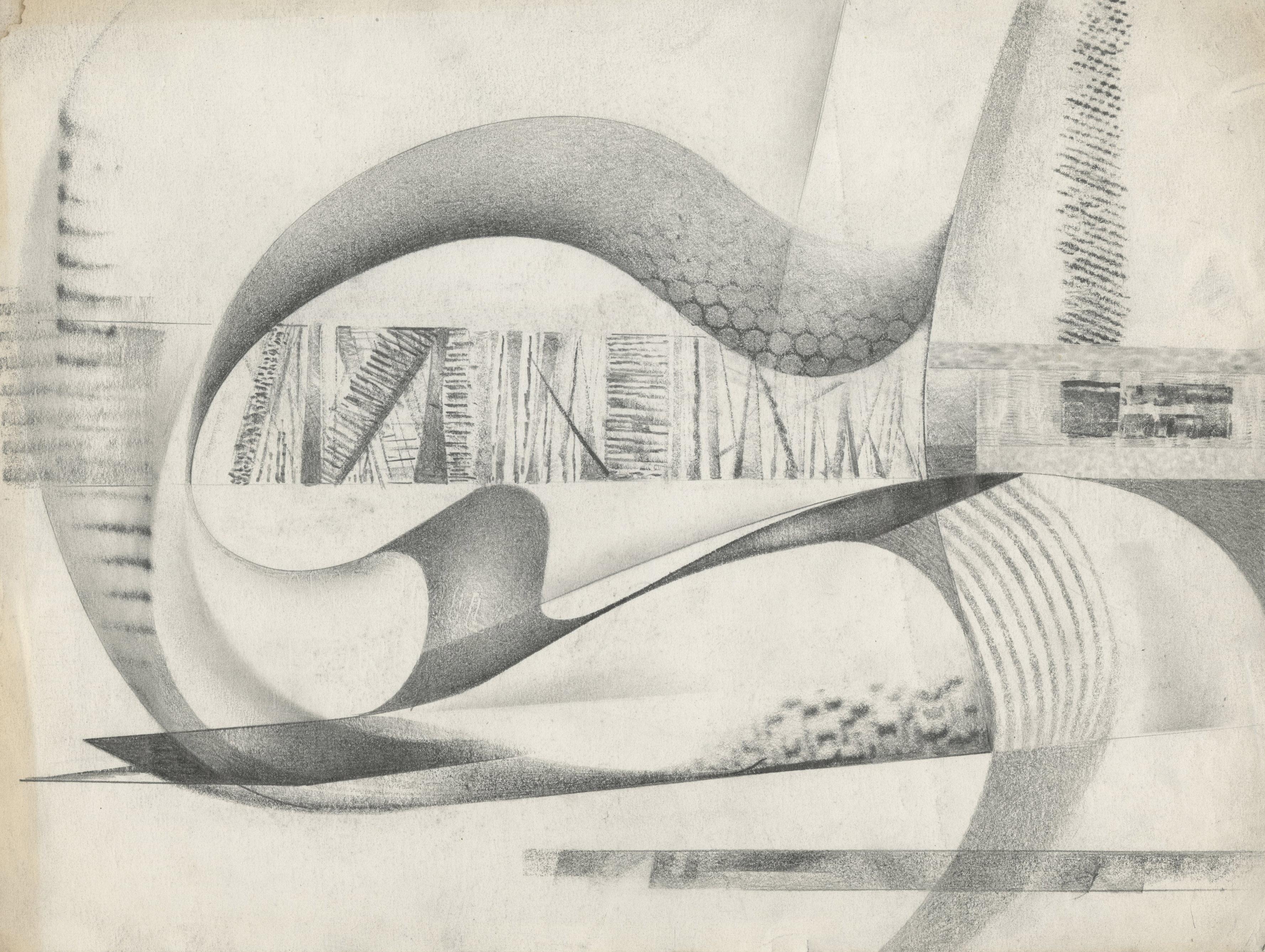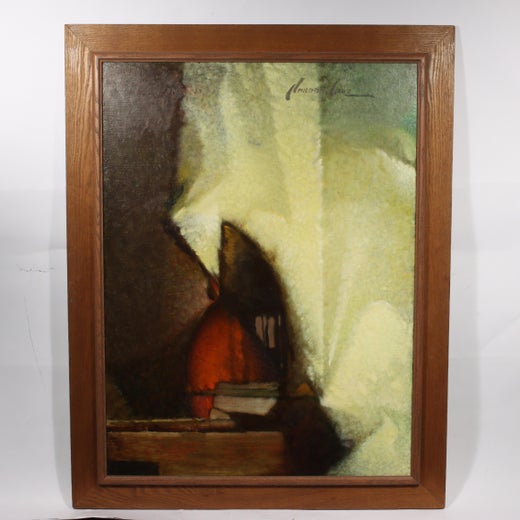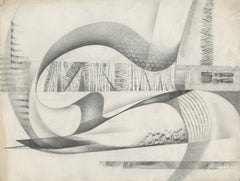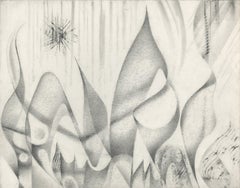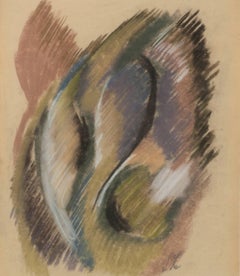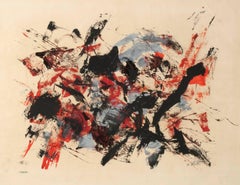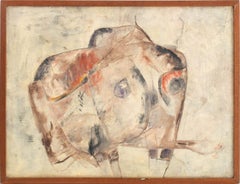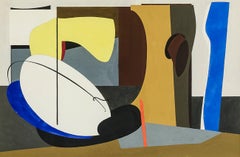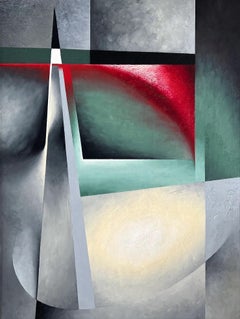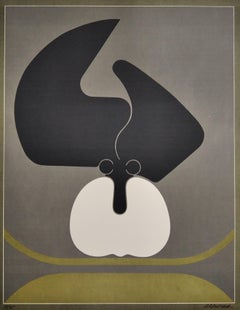Want more images or videos?
Request additional images or videos from the seller
1 of 10
Norbert Lenz#90 Strange Creature1932
1932
$2,500
£1,908.95
€2,173.41
CA$3,510.39
A$3,837.55
CHF 2,030.24
MX$45,922.44
NOK 25,831.84
SEK 23,646.43
DKK 16,234.03
About the Item
#90 Strange Creature
Oil and pencil on board, 1932
Signed and dated in the image lower right (see photo)
Provenance:
Joseph M. Erdelac, Cleveland, OH
Condition: excellent
Archival framing
Image size: 10 1/2 x 11 3/4 inches
Frame size: 25 x 24 inches
Painter, illustrator and commercial artist Norbert Lenz was born in Norwalk, Ohio and received his artistic training at both the Huntington Polytechnic Institute and the Cleveland School of Art. During his career Lenz exhibited his paintings and drawings at such institutions as the Pennsylvania Academy of Fine Art, the Art Institute of Chicago, the Cleveland Museum of Art and the Butler Institute of American Art. Today the art of Norbert Lenz is held by the Columbus Museum of Art, the Cleveland Museum of Art and the Butler Institute of American Art.
Lenz was also a very highly regarded commercial designer of stamps. He worked for a number
of years at the House of Farman, a leading vendor of first day covers for stamp collectors. He
designed their decorative artwork or chacet, to enhance the stamp A cachet is a printed design on
an envelope that commemorates an event. House of Farnam was one of the largest and best-
known cachet-making companies. A First Day Cover is an envelope bearing a stamp which is
cancelled on the day the stamp is initially placed on sale by the postal authorities.
- Creator:Norbert Lenz (1900 - 1992, American)
- Creation Year:1932
- Dimensions:Height: 10.5 in (26.67 cm)Width: 11.75 in (29.85 cm)
- Medium:
- Movement & Style:
- Period:
- Condition:Framed with conservation clear acrylic. Frame: 25 x 24".
- Gallery Location:Fairlawn, OH
- Reference Number:Seller: FA89431stDibs: LU14011838682
Norbert Lenz
Norbert Lenz [1900-1992] Born: Norwalk, Ohio; March 2, 1900.
Education : Cleveland School of Art; Huntington Polytechnic Institute.
Member : Cleveland School of Art.
Exhibitions : Pennsylvania Academy of Fine Art 1930 - 1939; Art Institute of Chicago 1936; Butler Art Institute 1943 and 1944 Cleveland Museum of Art 1930 - 1944; Ohio Water Color Exhibition 1945.
About the Seller
5.0
Recognized Seller
These prestigious sellers are industry leaders and represent the highest echelon for item quality and design.
Gold Seller
Premium sellers maintaining a 4.3+ rating and 24-hour response times
Established in 1978
1stDibs seller since 2013
834 sales on 1stDibs
Typical response time: <1 hour
Associations
International Fine Print Dealers Association
- ShippingRetrieving quote...Shipping from: Fairlawn, OH
- Return Policy
More From This Seller
View AllUntitled Abstraction
By Medard P. Klein
Located in Fairlawn, OH
Untitled Abstraction
Graphite on paper. c. 1946
Unsigned
Provenance: Estate of the Artist
Inherited by his neighbor/caregiver
Condition: Staining at corners
...
Category
1940s Abstract Abstract Drawings and Watercolors
Materials
Graphite
Untitled Abstraction
By Medard P. Klein
Located in Fairlawn, OH
Untitled Abstraction
Graphite on paper, c. 1946
Signed with the estate stamp verso
Provenance: estate of the Artist
Inherited by his neighbor/caregiver
Conditio...
Category
1940s Abstract Abstract Drawings and Watercolors
Materials
Graphite
Untitled
By Leon Kelly
Located in Fairlawn, OH
Untitled
Pastel on paper, 1922
Initialed lower right (see photo)
Exhibited: Francis Nauman, Leon Kelly: Draftsman Extraordinaire, New York, April 4 - May 23, 2014.
Condition: Excell...
Category
20th Century American Modern Abstract Drawings and Watercolors
Materials
Pastel
$4,000
Untitled Abstraction
By John von Wicht
Located in Fairlawn, OH
Untitled Abstrraction
Gouache, watercolor and pigments on paper, c. 1960
Signed lower right in pencil (see photo)
Image: 17 x 22 inches
Sheet: 25 1/4 x 29 3/4 inches
Frame: 25 1/4 x ...
Category
1960s Abstract Expressionist Abstract Drawings and Watercolors
Materials
Watercolor
Untitled
By Leon Kelly
Located in Fairlawn, OH
Untitled
Pastel on paper, 1922
Signed with the artist's initials in pencil
Provenance: Estate of the artist
Francis M. Nauman (label)
Private collection, NY
A very early abstract/cubist work by Kelly. Created while the artist was studying with Arthur Carles in Philadelphia.
Leon Kelly (October 21, 1901 – June 28, 1982) was an American artist born in Philadelphia, PA. He is most well known for his contributions to American Surrealism, but his work also encompassed styles such as Cubism, Social Realism, and Abstraction. Reclusive by nature, a character trait that became more exaggerated in the 1940s and later, Kelly's work reflects his determination not to be limited by the trends of his time. His large output of paintings is complemented by a prolific number of drawings that span his career of 50 years. Some of the collections where his work is represented are: The Metropolitan Museum in New York, The Whitney Museum of American Art, the Museum of Modern Art, the Philadelphia Museum of Art, and Boston Public Library.
Biography
Kelly was born in 1901 at home at 1533 Newkirk Street, Philadelphia, PA. He was the only child of Elizabeth (née Stevenson) and Pantaleon L. Kelly. The family resided in Philadelphia where Pantaleon and two of his cousins owned Kelly Brothers, a successful tailoring business. The prosperity of the firm enabled his father to purchase a 144-acre farm in Bucks County PA in 1902, which he named "Rural Retreat" It was here that Pantaleon took Leon to spend every weekend away from the pressures of business and from the disappointments in his failing marriage. Idyllic and peaceful memories of the farm stayed with Leon and embued his work with a love of nature that emerged later in the Lunar Series, in Return and Departure, and in the insect imagery of his Surrealist work. "If anything," he once said,"I am a Pantheist and see a spirit in everything, the grass, the rocks, everything."
At thirteen, Leon left school and began private painting lessons with Albert Jean Adolphe, a teacher at the School of Industrial Art (now the University of the Arts) in Philadelphia. He learned technique by copying the works of the old masters and visiting the Philadelphia Zoo, where he would draw animals. Drawings done in 1916 and 1917 of elephants, snakes and antelope, as well as copies of old master paintings by Holbein and Michelangelo, heralded an impressive emerging talent. In 1917, he studied sculpture with Alexander Portnoff but his studies came to an abrupt halt with the start of World War I. Being too young to enlist, he joined the Quartermaster Corp at the Army Depot in Philadelphia, where he served for more than a year loading ships with supplies and, along with other artists, working on drawings for camouflage.
By 1920, the family's fortunes drastically changed. His father's business had failed due to the introduction of ready made clothing and his marriage, unhappy from the beginning, dissolved. Broken by circumstance Pantaleon left Philadelphia to begin a wandering existence looking for work leaving Leon to support his mother and grandmother. He found a job in 1920 at the Freihofer Baking Company where he worked nights for the next four years. Under these circumstances Leon continued to develop his skills in drawing and painting and learned of the revolutionary developments in art that were taking place in Paris.
During the day he was granted permission to study anatomy at the Philadelphia School of Osteopathy where he dissected a cadaver and perfected his knowledge of the human figure. He also met and studied etching with Earl Horter, a well known illustrator, who had amassed a significant collection of modern art which included work by Brancusi, Matisse, and Cubist works by Picasso and Braque. Among the artists around Horter was Arthur Carles, a charismatic and controversial painter who taught at the Pennsylvania Academy of Fine Arts. Leon enrolled in the Academy in 1922, becoming what Carles described as, "his best student".
In the next three years Leon work ranged from academic studies of plaster casts, to pointillism, to landscapes of Fairmount Park in Philadelphia, as well as a series of pastels showing influences from Matisse to Picasso. Clearly influenced by Earl Horter's collection and Arthur Carles he mastered analytical cubism in works such as The Three Pears, 1923 and 1925 experimented with Purism in Moon Behind the Italian House. In 1925 Kelly was awarded a Cresson Scholarship and on June 14 he left for Europe.
Paris
The first trip to Europe lasted for approximately three and a half months and introduced Kelly to a culture and place where he felt he belonged. Though he returned to the Academy in the Fall, he left for Europe again a few months later to begin a four-year stay in Paris. He moved into an apartment at 19 rue Daguerre in Paris and began an existence intellectually rich but in creature comforts, very poor. "I kept a cinderblock over the drain in the kitchen sink to keep the rats out of the apartment" he once explained. He frequented the cafes making acquaintances with Henry Miller, James Joyce and the critic Félix Fénéon as well as others. His days were split between copying old master paintings in the Louvre and pursuing modernist ideas that were swirling through the work of all the artists around him. The Lake, 1926 and Interior of the Studio, 1927, now in the Newark Museum.
Patrons during this time were the police official Leon Zamaran, a collector of Courbets, Lautrecs and others, who began collecting Kelly's work. Another was Alfred Barnes of the Barnes Collection in Philadelphia.
In 1929 Kelly married a young French woman, Henriette D'Erfurth. She appears frequently in paintings and drawings done between 1928 and the early 1930s.
Philadelphia
The stock market crash of 1929 made it impossible to continue living in Paris and Kelly and Henriette returned to Philadelphia in 1930. He rented a studio on Thompson Street and began working and participating in shows in the city's galleries. Work from 1930 to 1940 showed continuing influences and experimentation with the themes and techniques acquired in Paris as well as a brief foray into Social Realism. The Little Gallery of Contemporary Art purchased the Absinthe Drinker...
Category
1920s Abstract Abstract Drawings and Watercolors
Materials
Pastel
$4,000
Untitled
By Laddie John Dill
Located in Fairlawn, OH
Untitled
Watercolor on paper. 1971
Unsigned
Sheet size: 24 x 19 inches
Condition: Excellent
From the collection of Ileana Sonnabend (1914-2007)
Laddie John Dill, a Los Angeles artist...
Category
1970s Abstract Abstract Drawings and Watercolors
Materials
Watercolor
You May Also Like
Abstract Composition
Located in Astoria, NY
Jean Hebbeln (American, 1914-1956), Abstract Composition, Oil on Canvas, Art Students League of New York label verso, wood frame.
Image: 18.75" H x 24.75" W; frame: 20" H x 26" W.
...
Category
Mid-20th Century Abstract Abstract Paintings
Materials
Canvas, Oil
Untitled
By Charles Houghton Howard
Located in New York, NY
Charles Houghton Howard was born in Montclair, New Jersey, the third of five children in a cultured and educated family with roots going back to the Massachusetts Bay colony. His father, John Galen Howard, was an architect who had trained at M.I.T. and the École des Beaux-Arts in Paris and apprenticed in Boston with Henry Hobson Richardson. In New York, the elder Howard worked for McKim, Mead and White before establishing a successful private practice. Mary Robertson Bradbury Howard, Charles’s mother, had studied art before her marriage. John Galen Howard moved his household to California in 1902 to assume the position of supervising architect of the new University of California campus at Berkeley and to serve as Professor of Architecture and the first Dean of the School of Architecture (established in 1903). The four Howard boys grew up to be artists and all married artists, leaving a combined family legacy of art making in the San Francisco Bay area that endures to this day, most notably in design, murals, and reliefs at the Coit Tower and in buildings on the Berkeley campus.
Charles Howard graduated from the University of California at Berkeley in 1921 as a journalism major and pursued graduate studies in English at Harvard and Columbia Universities before embarking on a two-year trip to Europe. Howard went to Europe as a would-be writer. But a near-religious experience, seeing a picture by Giorgione in a remote town outside of Venice, proved a life-altering epiphany. In his own words, “I cut the tour at once and hurried immediately back to Paris, to begin painting. I have been painting whenever I could ever since” (Charles Howard, “What Concerns Me,” Magazine of Art 39 [February 1946], p. 63). Giorgione’s achievement, in utilizing a structured and rational visual language of art to convey high emotion on canvas, instantly convinced Howard that painting, and not literature, offered the best vehicle to express what he wanted to say. Howard returned to the United States in 1925, confirmed in his intent to become an artist.
Howard settled in New York and supported himself as a painter in the decorating workshop of Louis Bouché and Rudolph Guertler, where he specialized in mural painting. Devoting spare time to his own work, he lived in Greenwich Village and immersed himself in the downtown avant-garde cultural milieu. The late 1920s and early 1930s were the years of Howard’s art apprenticeship. He never pursued formal art instruction, but his keen eye, depth of feeling, and intense commitment to the process of art making, allowed him to assimilate elements of painting intuitively from the wide variety of art that interested him. He found inspiration in the modernist movements of the day, both for their adherence to abstract formal qualities and for the cosmopolitan, international nature of the movements themselves. Influenced deeply by Surrealism, Howard was part of a group of American and European Surrealists clustered around Julien Levy. Levy opened his eponymously-named gallery in 1931, and rose to fame in January 1932, when he organized and hosted Surrealisme, the first ever exhibition of Surrealism in America, which included one work by Howard. Levy remained the preeminent force in advocating for Surrealism in America until he closed his gallery in 1949. Howard’s association with Levy in the early 1930s confirms the artist’s place among the avant-garde community in New York at that time.
In 1933, Howard left New York for London. It is likely that among the factors that led to the move were Howard’s desire to be a part of an international art community, as well as his marriage to English artist, Madge Knight...
Category
20th Century American Modern Abstract Drawings and Watercolors
Materials
Paper, Gouache, Graphite
Abstract
Located in Los Angeles, CA
This painting is part of our exhibition Charles Goeller: A Wistful Loneliness.
Oil on canvas, 29 x 22 inches, Signed on frame verso “Painted by Charles L. Goeller”
Exhibited:
(Perh...
Category
1930s American Modern Abstract Paintings
Materials
Oil
Untitled
Located in Barcelona, BARCELONA
The painting is being offered with a work and authenticity certificate
Category
1980s Abstract Figurative Paintings
Materials
Lithograph
Metamorphosis - Oil Painting by Leo Guida - 1975
By Leo Guida
Located in Roma, IT
Metamorphosis is a contemporary artwork realized by Leo Guida in 1975.
Mixed colored oil painting
Includes frame: 117.5 x 78 cm
Leo Guida (1992 - 2017). Sensitive to current iss...
Category
1970s Abstract Abstract Paintings
Materials
Oil
Untitled
By Hans Burkhardt
Located in New York, NY
Lithograph, 1948. Signed by the artist and dated in pencil, lower right. Numbered 4/12 in pencil, lower left.
Category
1940s American Modern Abstract Prints
Materials
Lithograph
More Ways To Browse
Monochrome Abstract Painting
Avant Garde Painting
Julia Gray
Aqua Painting
Black And White Diptych Abstract Painting
Fort Lauderdale Florida
Muted Art
Rothko Painting
Paintings With Hearts
Blush Art
Exoticism Painting
Minimalist Red Art
Zen Paintings
Abu Dhabi
Damaged Painting
Simon Art Gallery
Gradient Painting
New York School Painting
